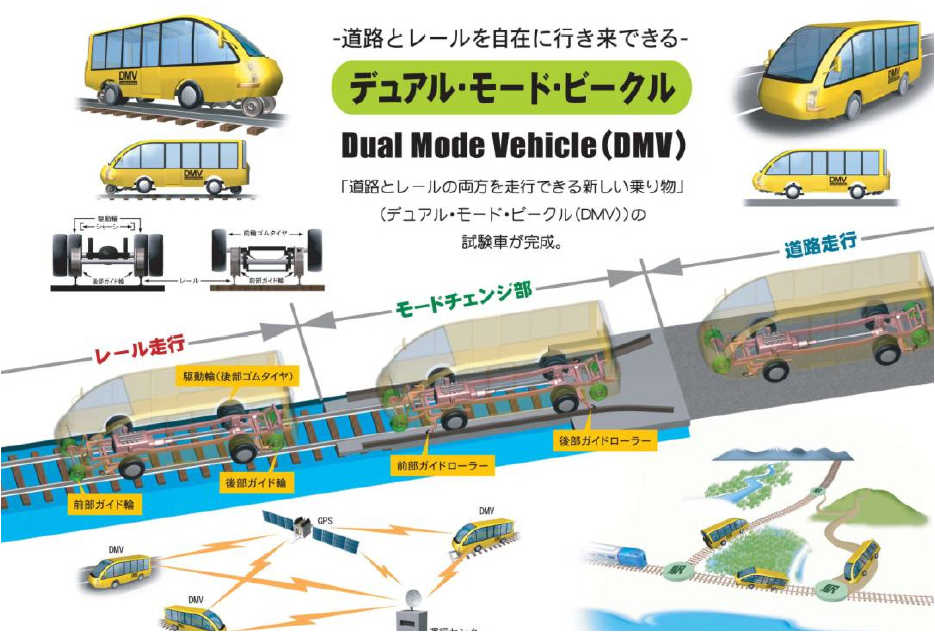I have frequently opined here about my desire for us to build our public transportation infrastructure towards our future, rather than from our past. Here is an example of what I envision.
One of the major problems facing system solutions for public transportation in Massachusetts is how we handle communities outside the immediate service area of the existing commuter rail routes. I suggest that the technology pictured here offers a solution. While these are prototypes (they show Japanese technology dating from 2006/2007), I believe they point towards an approach that is very promising for Massachusetts.
What if larger versions of these vehicles, about the size of an existing bus coach, were used throughout the state? Imagine, if you will, revised local bus routes that traverse towns like Palmer, Billerica, or Groton (chosen mostly randomly), picking up passengers in the morning and dropping them off in the evening. What if those buses, loaded with passengers, stopped for about thirty seconds at designated rail/highway transfer locations, dropped their (steel) rail wheels into place, perhaps coupled together into 4-5 car trains, and proceed to follow existing or perhaps new commuter rail routes to destinations in Boston, Worcester, Springfield, and perhaps Hartford, Nashua, Manchester, and so on?
It seems to me that this approach provides a solution towards the “last mile” problem that so bedevils public transportation in a geographic distribution like we have, preserves the efficiency of rail transportation for the longer portions of these trips, and is able to use whatever combination of highway and rail right-of-way that makes the most sense from a “system” view of our region.
Surely Massachusetts should be pursuing this technology as we belatedly invest in our collective future.

Schematic showing key components
Video showing prototype, carrying passengers
Transit is the buzzword for pro-growth communities all across America. While Romney-Ryan and some reactionary governors may have belittled high speed rail, it’s going to happen and it’s going to create jobs and lure investment wherever it is laid down. DC is getting a streetcar system, so is Charlotte, so is Dallas. If the old fashioned South can produce transit innovations and courageous leaders like Charlotte Mayor (and soon to be Secretary) Foxx and Kasim Reed in Atlanta, hotbeds of old 1950s car centric planning, surely one of the most innovative regions in the country can do the same. We need the Green Line extension, we need the South Coast railroad to work, and we need to expand commuter service into NH and to Worcester and Springfield. It’s time for these changes to happen!
As you probably know, jconway, DC once had a comprehensive streetcar system. It is documented in an easily digestible fashion at the Smithsonian’s National Museum of American History. It went the way of most of the streetcar systems of the previous century.
Ironically, the exhibition, “American on the Move”, is located in the “General Motors Hall of Transportation”.
I appreciate the support for investing in public transportation.
In this thread, I’m really attempting to draw attention to the ability of each of these DMVs to leave the rails and become a bus. No streetcar in America has ever been able to accomplish that before.
Consider, for example, the lengthy and interesting exchange we had last January on Systems thinking – transit reform, a thread started by pablo.
I’d like to revisit his hypotheticals:
– Alewife to Lowell
– How do you get out of Lexington
– Arlington center to Lowell
– Arlington center to Boston
All these are greatly delayed by the “impedance mismatch” between the origin (Alewife, Lexington, Arlington) and the destination (Lowell, Boston, Alewife). It appears to me, with these DMVs, that North Station suddenly becomes a far more attractive option. Commuters could board a vehicle in a neighborhood of Lowell and ride, in the same seat with no transfers, all the way to North Station. No buses, no connections, just ride.
I note that rail portions of these trips are unaffected by traffic and largely unaffected by weather. North Station is served by both the Green Line and the Orange Line — with only modest and obvious increases in service for each, the entire northern and north-western suburbs and exurbs are dramatically better served by public transit.
Meanwhile, NO new tracks, highways, platforms, and all that have to be built. That means that every dollar invested in such infrastructure can be directed towards areas that bring the maximum return in increased convenience.
Doesn’t this make more sense than spending tens of millions of dollars and at least five years to end up with new commuter rail coaches with all the disadvantages of the old ones?
BRTs with the dual use would be great too.
So did most cities, Cincinatti is actually using the old track lines for it’s new system. Boston is one of the few that didn’t get rid of theirs entirely, though my ma remembers the old A line to Watertown.
Many cities across Massachusetts used to have them — Lynn and Lowell are two that I’m aware of.
It was very sad that we let go of all that, largely due to the influence of the auto sector and expansion of highways.
There’s a perception that public transportation is expensive, but streetcars are incredibly affordable, or at least can be if systems don’t get too fancy with them.
…but there are plans in the works I believe to revitalize and expand Lowell’s trolley network into a public transit system and not just for National Park tourists.
a while back. It’s very exciting stuff and I hope the city goes through with it.